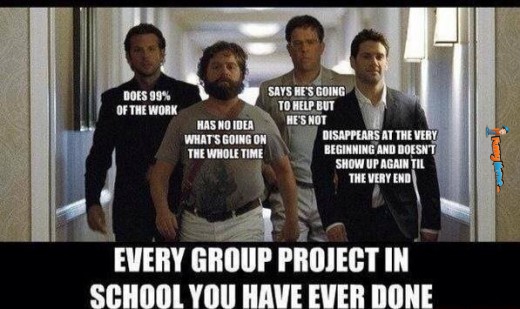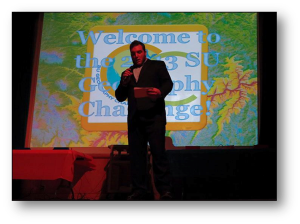The world is becoming increasingly "collaboratory." The old academic model–where researchers labored alone or solely with others from their own discipline–has been augmented by one in which researchers work with other researchers from other fields . . . collaboratory interdisciplinarity. We can also see this outside of academia, with public-private partnerships, joint business ventures, and grassroots NGO and not-for-profit consortia. Thus one of the most important skills that students can learn in college and university is how to work well with others. There is a good chance they will be doing this kind ofwork post-commencement. Today's SITETL (Summer Institute for Technology Enhanced Teaching and Learning at Syracuse University) sessions addressed this issue.

The challenges in making group work work are, I believe, two-fold: 1) finding ways to learn about and respect 'the other' and the talents/knowledge they bring to the table; and 2) fostering responsibility and accountability on the part of individuals members to the larger group. In other words, there needs to be mutual respect between members of the group as well as belief in, and commitment to, what the group is doing. While there are a variety of technologies out there that might assist in this–wikis, AdobeConnect, NB, Google Drive (formerly Google Docs), CATME.org–it really is all for naught in the context of a semester-long course if the project has goals that are amorphous.
During Fall 2013, I had the great privilege to be part of a course for which the group project worked. As part of GEO 491: Senior Seminar in Geography, I ask the students to subdivide into groups and come up with project(s) that will produce some sort of deliverable during National Geography Awareness Week (usually the third week in November, before American Thanksgiving.) In the past, groups generally go off to do their own small-group thing . . . and the Hangover Model often kicks into play. While great things always get delivered (working with local community groups or school classes around issues related to geography education), it is questionable the extent to which these four or five group projects each semester since 2006 were the product of all the students who took the GEO 491 course. My sense is that they are often the product of 45% of the students each semester (the Phils of the course), with the remaining 55% being Stus, Alans, and Dougs. While I had some end-of-the-semester checks built in to suss this out, I still wondered what Stu, Alan and Doug had learned about how to present geography-as-practice to a broader public.
In August 2013, GEO 491 basically threw this approach out the window and asked if they could do a "super-group" project. They wanted to put on a campus version of the National Geography Bee. Because everyone in the class knew and understood what this was, there was immediate buy-in. Because everyone knew and felt comfortable with the context in which this would be held (the campus on which they had lived for 3 years), there was no tendency to want to procrastinate. We immediately set to work figuring out what the various facets of this event would entail and within a week had an organization structure and work flow chart in place. After that, the students were able to indicate committee-assignment preferences . . . with two committee assignment per student: one for planning the event, and the other for doing work the night it took place. We ended up calling this thing the "SU Geography Challenge." We held it on Monday, November 18, 2013.
A lot of planning went into this event. Our class started by talking about Roger Downs' "On Being and Becoming a Geographer." Then we looked at "Geography for Life" (the national K-12 geography standards)–the original and the update. We also studied different forms of knowledge bees, bowls, and game shows, and the kinds of knowledge they test before we moved on to figure out a format. We also read a couple of articles and faculty "how to" manuals for knowledge assessment. For several weeks we practiced at writing questions for the event; including how to fact-check and do reliability testing. Ultimately, for academic and contest integrity purposes, we did not use the questions that the class produced (no problems; we simply did not want ANYONE to be able to come to us and say, "This was rigged.") Thus in the end, the seminar leader (me), used the 175 questions that the class had produced as inspiration for the nearly 200 questions I ultimately created for the event. (I also included some NAEP Grades 4 and 8 questions [noted as such in the program]; that was fun . . . and interesting!)
In the meantime, the class (17 students) divided themselves into planning groups: rules/regs/compliance, publicity, material preparation, donations, and event coordination. The first group learned all sorts of new things about the campus as a big piece of infrastructure, publicity created a great logo, facebook page https://www.facebook.com/sugeographychallenge, and youtube videos, e.g. http://www.youtube.com/watch?v=0UmUoIy1Plc (over 1,000 hits!) Materials prep got everything we needed to put on the event (programs, extra AV materials, etc.) and donations came up with an amazing array of prizes, including $500-worth of gift certificates, another $300-worth of door prizes, and signed SU sports memorabilia from the football team.

For the event, the class divided into several groups: "team wranglers," "stage crew," "registration/after-party," "judge wranglers," and "scorers/time-keepers." All this division of labor stuff put the students in a position to really get to know each other, and it also led to an incredibly smooth-running evening. Two students acted as the Emcees–one of whom suggested the idea of a contest like this in the first place at the very end of August (Kelly Montague) and one of whom is the Captain/Center for the SU football team and who most surely ought to have a career in sports broadcasting given his stage presence (Macky MacPherson: remember that name!) They did a terrific job.
Sure, there were glitches, but because it was all about having fun, we laughed it off. In the end, I was incredibly proud of what the students pulled together in 6 weeks.
The day after the Geography Challenge, when I was walking down the hallway to my classroom for my "U.S. Geography" class, a student (who I had never seen before) came up to me and said, "You were at that geography thing last night. You were running the powerpoints." I answered in the affirmative . . . and he replied, "THAT ROCKED!!!!!! That whole thing ROCKED!!!" I thanked him. Then he said, "I was thinking about it, but now I know for sure: I'm gonna declare geography as a major! I love that stuff and I want to be part of something like that when I'M a senior!"
Geography awareness had been raised on the SU Campus! And we did it collaboratively. A true group effort!
You must be logged in to post a comment.